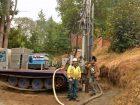
Features
Business
Success Stories
Passing the torch
Gradual transition, mutual respect make succession work for B.C.’s Red Williams Drilling
June 11, 2019 By Carolyn Camilleri
Red Williams Drilling Ltd. provides a range of services, including well drilling, water treatment, water delivery, and pump service, and covers an area of central Vancouver Island that stretches about 300 kilometres from the home base in Parksville.
While Red Williams Drilling was established in 1986, the company history goes back even farther.
“My grandfather’s company, Island Well Drilling, was started in 1958 out of Ladysmith,” says Thomas Williams, the third generation in a family of drillers.
Back then, only cable tools were used for drilling on Vancouver Island.
“In 1978, [Red Sr.] bought his first air rotary drill rig but continued to run the cable tool for years later,” Thomas says. “We still run the old cable tool to this day. Just last month, I completed a 250-foot, 10-inch well with the same rig.”
For several years, Island Well Drilling and Red Williams Drilling were separate businesses.
“In the early to mid-80s, when we had the economic downturn, there was work available but it wasn’t close to home,” Red says. “My father [Red Sr.] wasn’t interested in taking on that kind of work. He’d always been home-based, always worked within a certain radius, but there was no work for me.”
Red had been working with his father since childhood, and by the time he was 13 or 14, he was running equipment on his own. Rather than stay where there was no work, Red started his own business, taking on jobs farther away using equipment his father provided on “very generous terms.”
“I went out there and made all my mistakes and cut my teeth and learned how to organize a business,” Red says.
He was careful not to compete with his father.
“I drilled rock when I was out of his area, but I would never compete against him on rock work,” Red says. “I would do the overburden work and unconsolidated work for him.”
Red slowly took on more of the jobs, and by the time Red Sr. retired in the mid-1990s, Red Williams Drilling had acquired Island Well Drilling.
“My father ran a very clean, organized business, so there were no liabilities I had to worry about,” Red says.
VALUABLE OUTSIDE EXPERIENCES
Although Thomas worked with his father through his school years, he didn’t officially join the family business as a driller until 2003.
“I never wanted to work for my dad as a teenager,” he says. “After high school, I worked for one year doing mostly pump work for Red Williams Well Drilling. Following that, I took a one-year automotive trade course at Vancouver Island University.”
When his coursework was complete, he was offered apprenticeship jobs for a disappointing $10 per hour.
“By this time in my life, I had worked with my father’s company for several summers and was capable of drilling on my own,” Thomas says. “I could make $18 per hour at that time running a rig, so I followed the money and eventually ended up loving what I do.”
When the busy summer season was done, Thomas often worked in the oil patch, where he met drillers from across the country and was exposed to new equipment. Red sees value in Thomas’s experiences.
“He had to get out of the cage to find out what’s out there and to realize the cage wasn’t so bad,” Red says with a laugh.
Thomas put his time “out of the cage” to good use.
“Instead of going to university, he went to the oil fields, which, for us, is our university,” Red says. “He got educated and he put this education back in, so in a lot of respects, he’s better qualified than me. He’s brought something into the company.”
An area of particular interest for Thomas is equipment, and a big factor in his decision to keep drilling was the purchase of a rig that was more user-friendly and reliable than the older rigs.
“We spent several hundreds of thousands of dollars on equipment because of that new knowledge and opened up a few new venues in business that we wouldn’t otherwise have if he hadn’t done this work,” Red says.
Thomas says equipment represents the biggest change in the industry.
“Our rigs now can drill up to 400 feet of hard rock in a single shift, whereas, in the past, a well like this, drilling through hard rock, would take up to a couple of weeks to complete,” Thomas says.
While Thomas strives to update equipment, he understands his father doesn’t share that priority.
“Red sees a 30-year-old drill rig or pump hoist that is well maintained as better, because they are simpler,” he says, explaining that with less wiring and fewer electronic controls, problems are easier to diagnose in the field.
Thomas is mindful of the risks.
“The biggest challenge I see in our company is updating our aging fleet without acquiring large amounts of debt,” he says. “Even since I started in the industry, we have seen some slow times, and if we had large lease payments, we could have lost everything. We have over 20 pieces of equipment on the road and the average age is early 90s.”
The purchase of newer equipment is worked into the transition plan, with Thomas taking on more ownership with each capital investment.
“It’ll be a soft takeover, you might say,” Red says.
Another difference in perspective between father and son: “We do a lot more commercial drilling and large pump systems since I started managing and estimating,” says Thomas. “Red never had the patience for the days of work it can take to estimate a large drilling or pump job and writing up the safety plans and shop drawings.”
{gallery}4709
Print this page

